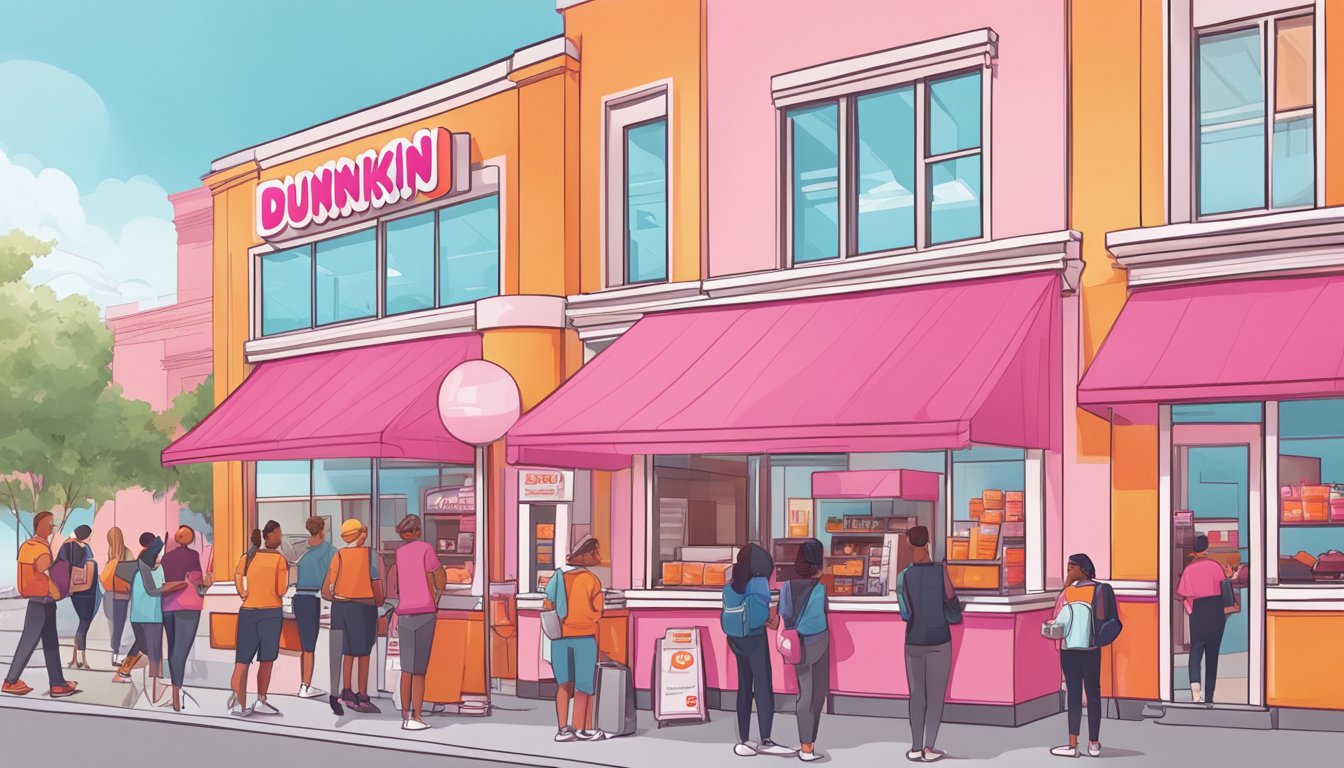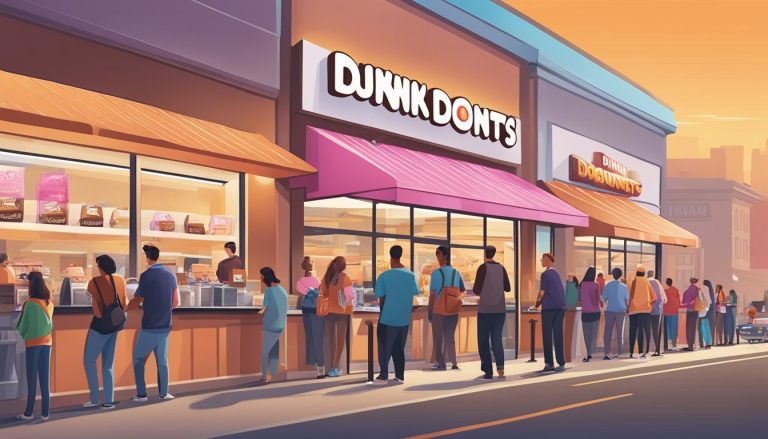Dunkin’ has become an iconic fixture in American coffee culture since its founding in 1950. What started as a modest doughnut shop in Quincy, Massachusetts quickly evolved into a coffee-centric enterprise that now boasts over 13,000 locations worldwide. Dunkin’ plays a significant role in shaping American coffee habits, serving as a daily ritual for millions and embodying the fast-paced, on-the-go lifestyle associated with modern coffee consumption.
The company’s success stems from its ability to adapt to changing consumer preferences. As health-conscious trends emerged, Dunkin’ shifted its focus from baked goods to coffee, recognizing the beverage as a daily necessity rather than an occasional treat. This strategic pivot allowed Dunkin’ to remain relevant and continue growing its customer base.
Dunkin’s influence extends beyond just serving coffee. The brand has ingrained itself into American culture through effective marketing strategies and its ubiquitous presence across the country. Operating in nearly every U.S. state, Dunkin’ has become synonymous with affordable, accessible coffee that fuels the nation’s productivity, as reflected in its popular slogan “America Runs on Dunkin’.”
Dunkin’s Origins and Historical Impact
Dunkin’ has played a significant role in shaping American coffee culture since its inception. The brand’s journey from a small shop to a global powerhouse reflects changing consumer tastes and business innovation.
William Rosenberg and Quincy, Massachusetts
William Rosenberg founded “Open Kettle” in 1948 in Quincy, Massachusetts. The restaurant served donuts for five cents and premium coffee for ten cents. Rosenberg renamed it “Dunkin’ Donuts” in 1950 after brainstorming with executives.
The original shop focused on quality coffee and donuts at affordable prices. This formula quickly gained popularity among local workers and residents.
Rosenberg’s vision extended beyond a single store. He developed a franchising model that allowed rapid expansion while maintaining consistent quality and service.
Transition from Dunkin’ Donuts to Dunkin’
In 2019, the company rebranded from Dunkin’ Donuts to simply Dunkin’. This change reflected a shift in focus towards beverages, particularly coffee.
The rebranding aimed to highlight Dunkin’s diverse menu offerings beyond donuts. It also simplified the brand name for broader appeal.
Coffee had become increasingly central to Dunkin’s identity. The new name emphasized this evolution while retaining the familiar “Dunkin'” portion of the brand.
Expansion and Becoming an Iconic Brand
Dunkin’ experienced rapid growth through franchising. By the 1960s, the brand had expanded beyond New England.
International expansion began in the 1970s. Dunkin’ adapted its menu to suit local tastes in different countries.
The company’s orange and pink color scheme became instantly recognizable. This visual branding helped cement Dunkin’s status as an iconic American brand.
Dunkin’ has over 13,000 locations worldwide as of 2025. It operates in nearly every U.S. state, maintaining strict quality standards for its coffee.
The brand’s success stems from its ability to evolve while staying true to its roots. Dunkin’ continues to be a cornerstone of American coffee culture.
Cultural Significance of Dunkin’ in America

Dunkin’ has become deeply ingrained in American culture, shaping coffee consumption habits and establishing itself as a beloved brand across the nation. Its impact extends beyond mere coffee and donuts, influencing daily routines and regional identities.
‘America Runs on Dunkin” Campaign
The iconic slogan “America Runs on Dunkin'” perfectly encapsulates the brand’s cultural significance. Launched in 2006, this campaign resonated with Americans by highlighting Dunkin’s role in fueling their busy lives. The catchy phrase became part of everyday language, reinforcing Dunkin’s position as an essential part of American mornings.
The campaign’s success stemmed from its ability to connect with customers on a personal level. It portrayed Dunkin’ as a reliable friend, always there to provide a caffeine boost and a tasty treat. This emotional connection helped solidify Dunkin’s place in American culture.
Contribution to the American Coffee Scene
Dunkin’ played a crucial role in democratizing coffee consumption in America. By offering affordable, consistently good coffee, the brand made quality brews accessible to a wider audience. This approach contrasted with more upscale coffee shops, positioning Dunkin’ as the everyday person’s coffee destination.
The company’s focus on drip coffee and flavored options helped shape American coffee preferences. Dunkin’s menu innovations, like the introduction of cold brew and espresso-based drinks, kept pace with evolving tastes while maintaining its core identity.
Dunkin’s influence extended to home brewing habits. Many Americans sought to recreate the Dunkin’ experience at home, leading to increased sales of the brand’s packaged coffee and K-Cups.
Regional Power Brand and National Presence
Dunkin’ originated in New England and grew into a powerful regional brand before expanding nationwide. In its home region, particularly in Massachusetts, Dunkin’ holds an almost cult-like status. The brand’s ubiquity in New England towns became a source of local pride and identity.
As Dunkin’ expanded across the country, it maintained strong regional loyalty while gaining national recognition. The company adapted its offerings to suit local tastes in different areas, ensuring relevance across diverse markets.
Dunkin’s growth to over 13,000 locations worldwide, with a presence in nearly all U.S. states, solidified its status as a national icon. This widespread availability made Dunkin’ a familiar sight on American streets, further embedding it in the country’s cultural landscape.
Menu Evolution and Innovation

Dunkin’ has undergone significant menu transformations since its inception, adapting to changing consumer tastes and market trends. The company expanded beyond its donut roots to offer a diverse array of food and beverage options.
From Donuts to a Diverse Food Menu
Dunkin’ began as a donut shop but gradually broadened its food offerings. In the 1980s and 1990s, the company introduced muffins and bagels to cater to a wider breakfast crowd. Breakfast sandwiches soon followed, providing heartier options for on-the-go customers.
The menu expanded to include croissants, wraps, and healthier choices like oatmeal. Dunkin’ also introduced seasonal items and limited-time offers to keep the menu fresh and exciting.
Beverage Innovation: Cold Brew to Nitro Coffee
Dunkin’ made significant strides in beverage innovation. The company launched its Cold Brew coffee in 2016, tapping into the growing demand for smoother, less acidic cold coffee options.
In 2018, Dunkin’ introduced Nitro Coffee, infusing cold brew with nitrogen for a creamy texture. This move positioned the brand as a serious competitor in the specialty coffee market.
Energy drinks and flavored teas were added to attract a younger demographic and diversify the beverage lineup.
Menu Innovation and Consumer Preferences
Dunkin’ closely monitors consumer preferences to guide its menu innovation. The company has introduced plant-based options, including Beyond Meat breakfast sandwiches, to cater to health-conscious and vegetarian customers.
Customization options have expanded, allowing customers to personalize their drinks with various flavors and milk alternatives. Dunkin’ also embraced digital ordering and loyalty programs to enhance the customer experience.
Seasonal flavors and limited-time offers create excitement and drive repeat visits. These innovations have helped Dunkin’ stay relevant in a competitive market.
Marketing and Customer Engagement
Dunkin’ has leveraged innovative marketing strategies and customer-centric approaches to solidify its position in American coffee culture. The company’s efforts span targeted advertising, loyalty programs, and strategic repositioning in the competitive coffee market.
Targeted Advertising Campaigns
Dunkin’ executes multi-channel advertising campaigns to reach diverse consumer segments. Television spots highlight the brand’s coffee offerings and breakfast items, often featuring catchy jingles and relatable scenarios. Print ads in magazines and newspapers emphasize Dunkin’s affordability and convenience.
Digital marketing plays a crucial role, with social media campaigns encouraging user-generated content and engagement. The company utilizes influencer partnerships to amplify its message, particularly on Instagram where food and beverage content thrives.
Seasonal promotions, like pumpkin-flavored products in fall, are heavily marketed to capitalize on trending flavors and create buzz.
Loyalty Programs and Customer Experience
The DD Perks loyalty program forms a cornerstone of Dunkin’s customer engagement strategy. Members earn points on purchases, redeemable for free beverages. This system encourages repeat visits and provides valuable consumer data.
Mobile ordering through the Dunkin’ app enhances customer experience by reducing wait times. The app also sends personalized offers based on purchase history, fostering a sense of individual attention.
In-store experience focuses on speed and friendliness. Staff training emphasizes quick service without sacrificing quality, aligning with the brand’s “America Runs on Dunkin'” slogan.
Repositioning Effort in the Coffee Market
Dunkin’ has made concerted efforts to reposition itself as a serious coffee destination. The company dropped “Donuts” from its name in 2019, signaling a stronger focus on beverages.
Menu expansions include premium espresso-based drinks and cold brew options, directly competing with specialty coffee shops. Dunkin’ has also introduced plant-based milk alternatives to cater to changing consumer preferences.
Store redesigns feature modern aesthetics and comfortable seating areas, encouraging longer visits. This shift aims to attract a younger demographic and position Dunkin’ as a viable work or meeting space.
Technological Advances and Convenience

Dunkin’ has embraced technology and convenience to enhance the customer experience. The company has implemented mobile ordering, redesigned stores, and streamlined drive-thru services to cater to busy lifestyles.
Mobile App and Ordering System
Dunkin’s mobile app revolutionized how customers interact with the brand. The app allows users to place orders in advance, skip lines, and earn rewards. It features a user-friendly interface for quick customization of drinks and food items.
The app also integrates with Dunkin’s loyalty program, encouraging repeat visits. Customers can track their points, redeem rewards, and receive personalized offers based on their preferences.
Push notifications keep users informed about new products and promotions. The app’s location services help customers find nearby stores and check wait times.
Drive-Thru and Store Design for Busy Lives
Dunkin’ has reimagined its store layouts to prioritize speed and efficiency. Drive-thru lanes are equipped with digital menu boards and advanced ordering systems to reduce wait times.
Many locations now feature dedicated pickup areas for mobile orders. This allows customers to grab their pre-ordered items without waiting in line.
Store interiors are designed with separate counters for coffee and food orders. This helps manage traffic flow and reduces congestion during peak hours.
Dunkin’ has also introduced smaller-format stores in high-traffic areas like airports and college campuses. These locations focus on grab-and-go items and quick service for customers on the move.
Sustainable Practices and Social Responsibility

Dunkin’ has made significant strides in implementing sustainable practices and demonstrating social responsibility. The company has set ambitious goals and partnered with various organizations to address environmental concerns and support local communities.
Environmental Sustainability Initiatives
Dunkin’ has committed to sourcing 100% of its coffee responsibly by 2025. This initiative aims to ensure ethical and sustainable practices throughout their supply chain. The company has partnered with Enveritas, a non-profit organization, to verify and improve standards with U.S. roasters and international licensees.
Dunkin’ also focuses on reducing its environmental impact. They have introduced more eco-friendly packaging options and implemented energy-efficient technologies in their stores. The company offers 30% Rainforest Alliance Certified Iced Green Tea in select U.S. markets, demonstrating their commitment to sustainable sourcing beyond coffee.
Community Engagement and Partnerships
Dunkin’ actively engages in community support and partnerships to drive positive change. The company has joined the Sustainable Coffee Challenge, a collaborative effort led by Conservation International. In 2021, Dunkin’ committed $110,000 to become a premier-level sponsor of this initiative.
The Dunkin’ Joy in Childhood Foundation supports children’s health and hunger relief programs. Through this foundation, the company partners with local organizations to make a difference in communities across the country. Dunkin’ also encourages its franchisees to participate in local charitable activities and community events.
Franchising Model and Global Expansion
Dunkin’ has leveraged franchising as a key strategy for rapid growth and international expansion. This approach has allowed the company to establish a widespread presence while maintaining consistent quality and service across locations.
Franchise Growth and Development
Dunkin’ adopted franchising as its primary growth model in 1950. This decision proved instrumental in the company’s rapid expansion across the United States. Franchising allowed Dunkin’ to tap into local entrepreneurs’ knowledge and resources while maintaining control over brand standards.
The company carefully selects franchisees and provides comprehensive training and support. This ensures consistency in product quality and customer experience across all locations. Dunkin’ offers various franchise options, including single-unit and multi-unit opportunities.
Franchisees benefit from Dunkin’s established brand recognition and proven business model. The company continually updates its menu and store designs to stay competitive in the quick-service restaurant industry.
Dunkin’s Global Presence
Dunkin’ has successfully expanded its franchise model beyond U.S. borders. The company’s international growth strategy focuses on adapting to local tastes while maintaining core brand elements.
As of 2025, Dunkin’ operates in over 40 countries worldwide. Key international markets include South Korea, the Philippines, and Germany. The company tailors its menu offerings to suit regional preferences, such as taro-filled donuts in China and Mango Coolatta in Latin America.
Dunkin’ partners with local franchisees who understand their markets’ unique cultural and economic factors. This approach has helped the brand navigate challenges in foreign markets and establish a strong global presence.
The company’s expansion plan aims to increase its international footprint further. Dunkin’ continues to seek opportunities in emerging markets with growing middle-class populations and a rising demand for coffee and baked goods.
Competition and Market Position

Dunkin’ faces intense competition in the coffee and quick-service restaurant industry. The brand has carved out a distinct position through its coffee offerings, menu variety, and value proposition.
Comparisons to Starbucks and Others
Dunkin’ competes directly with Starbucks, the dominant player in the coffee market. Starbucks holds a 39.3% share of the US retail coffee market, presenting a formidable challenge. McDonald’s McCafé line also vies for similar customers.
Dunkin’ differentiates itself through more affordable pricing and a focus on quick service. Its menu appeals to a broad demographic range, from teenagers to retirees.
The brand operates in a monopolistic competition market, with many firms selling differentiated products and low barriers to entry. This structure drives ongoing innovation and customer-focused strategies.
Unique Selling Propositions of Dunkin’
Dunkin’ stands out through its emphasis on convenience, variety, and affordability. The brand offers a wide range of coffee options alongside its signature donuts and breakfast items.
Its fast service model caters to on-the-go consumers seeking quick, reliable food and beverage options. Dunkin’ has successfully positioned itself as an everyday, accessible choice for coffee and snacks.
The company’s expansion into new markets and product offerings, such as specialty coffees, helps it compete with both local coffee shops and global chains. This strategy allows Dunkin’ to tap into growing demand for premium coffee experiences while maintaining its core value proposition.
Consumer Trends and Future Outlook
Dunkin’ continues to adapt to evolving consumer preferences while shaping the future of the coffee industry. The company’s strategies focus on innovation and meeting the changing needs of coffee drinkers.
Adapting to Changing Consumer Preferences
Dunkin’ has shifted its focus to cater to health-conscious consumers. The company now offers a wider range of beverages, including espresso-based drinks and cold brew options.
To appeal to younger demographics, Dunkin’ has introduced plant-based milk alternatives and reduced-sugar options. These additions reflect the growing demand for customizable and healthier drink choices.
Convenience remains a priority. Dunkin’ has expanded its mobile ordering and delivery services to meet the needs of busy customers who value quick, on-the-go options.
Predictions for the Coffee Industry
The U.S. coffee market is projected to grow significantly, with revenue expected to reach $115 billion by 2030. This growth is driven by the rising popularity of specialty coffee and ready-to-drink beverages.
Sustainability and ethical sourcing are becoming increasingly important to consumers. Coffee companies, including Dunkin’, are likely to emphasize their commitment to responsible sourcing practices.
Innovative brewing methods and unique flavor profiles are expected to gain traction. Dunkin’ may introduce new coffee blends and brewing techniques to stay competitive in the evolving market.
Personalization will play a crucial role in the future of coffee consumption. Dunkin’ might explore AI-driven recommendations and customized drink options to enhance the customer experience.




